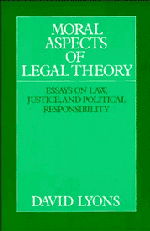Book contents
- Frontmatter
- Contents
- Preface
- Acknowledgments
- 1 The internal morality of law
- 2 On formal justice
- 3 Legal formalism and instrumentalism - a pathological study
- 4 Moral aspects of legal theory
- 5 Formal justice and judicial precedent
- 6 Derivability, defensibility, and the justification of judicial decisions
- 7 Constitutional interpretation and original meaning
- 8 A preface to constitutional theory
- 9 Basic rights and constitutional interpretation
- 10 Critical analysis and constructive interpretation
9 - Basic rights and constitutional interpretation
Published online by Cambridge University Press: 10 December 2009
- Frontmatter
- Contents
- Preface
- Acknowledgments
- 1 The internal morality of law
- 2 On formal justice
- 3 Legal formalism and instrumentalism - a pathological study
- 4 Moral aspects of legal theory
- 5 Formal justice and judicial precedent
- 6 Derivability, defensibility, and the justification of judicial decisions
- 7 Constitutional interpretation and original meaning
- 8 A preface to constitutional theory
- 9 Basic rights and constitutional interpretation
- 10 Critical analysis and constructive interpretation
Summary
This paper considers some strategies of constitutional interpretation. It suggests an approach aimed at promoting judicial decisions that are morally defensible as well as legally justifiable.
Section 1 raises the problem of interpretation in connection with the Dred Scott decision. Section 2 suggests how interpretive claims can be surprising yet innocuous even in controversial cases such as Griswold v. Connecticut. Section 3 considers interpretation based on “original intent,” which it reinterprets sympathetically. Section 4 grounds the recommended approach on a right to be free from morally indefensible coercive regulation. Section 5 returns to Dred Scott, and Section 6 suggests both an interpretive argument and the moral limits of the recommended approach.
The Supreme Court made one of its most controversial decisions in Dred Scott v. Sandford. The case originated in 1846 when Dred and Harriet Scott each began proceedings in the Missouri courts to establish that they and their children had been emancipated from slavery. Given their histories and Missouri precedent, their claims were neither novel nor implausible, and the prospects for a favorable outcome must have seemed good.
Dred Scott had been owned as a slave in Missouri by Dr. John Emerson, who took Scott with him in 1833 to a U.S. Army post in Illinois. They lived in that free state for more than two years. In 1836 Emerson took Scott with him to another army post, in the upper part of the Louisiana Territory, where slavery had been prohibited by Congress.
- Type
- Chapter
- Information
- Moral Aspects of Legal TheoryEssays on Law, Justice, and Political Responsibility, pp. 185 - 201Publisher: Cambridge University PressPrint publication year: 1993
- 1
- Cited by



